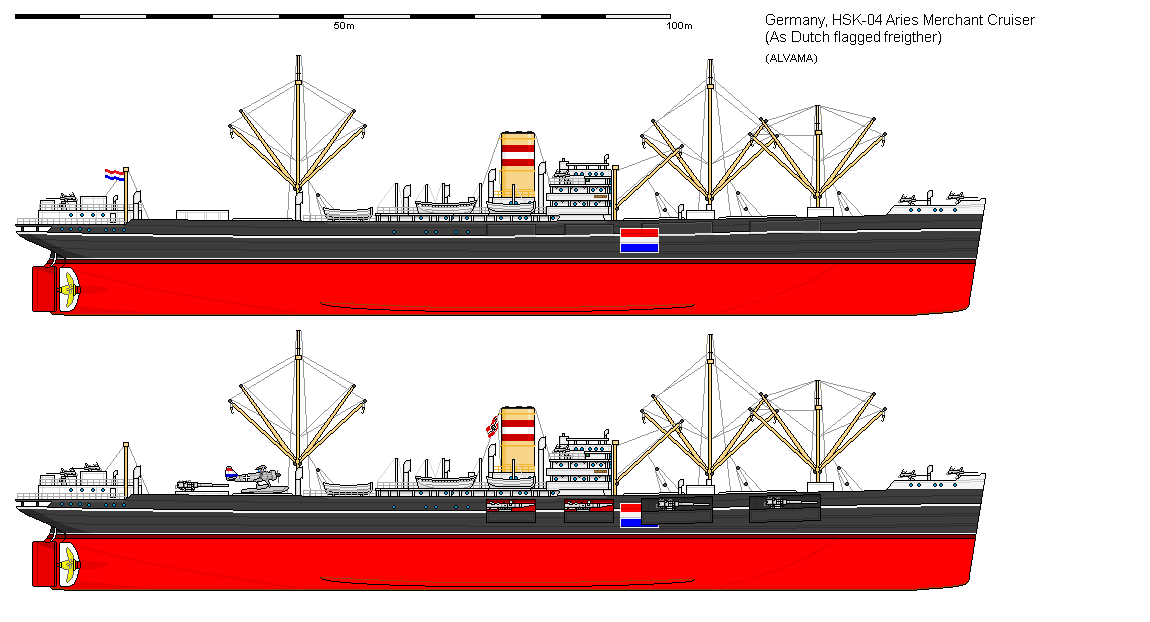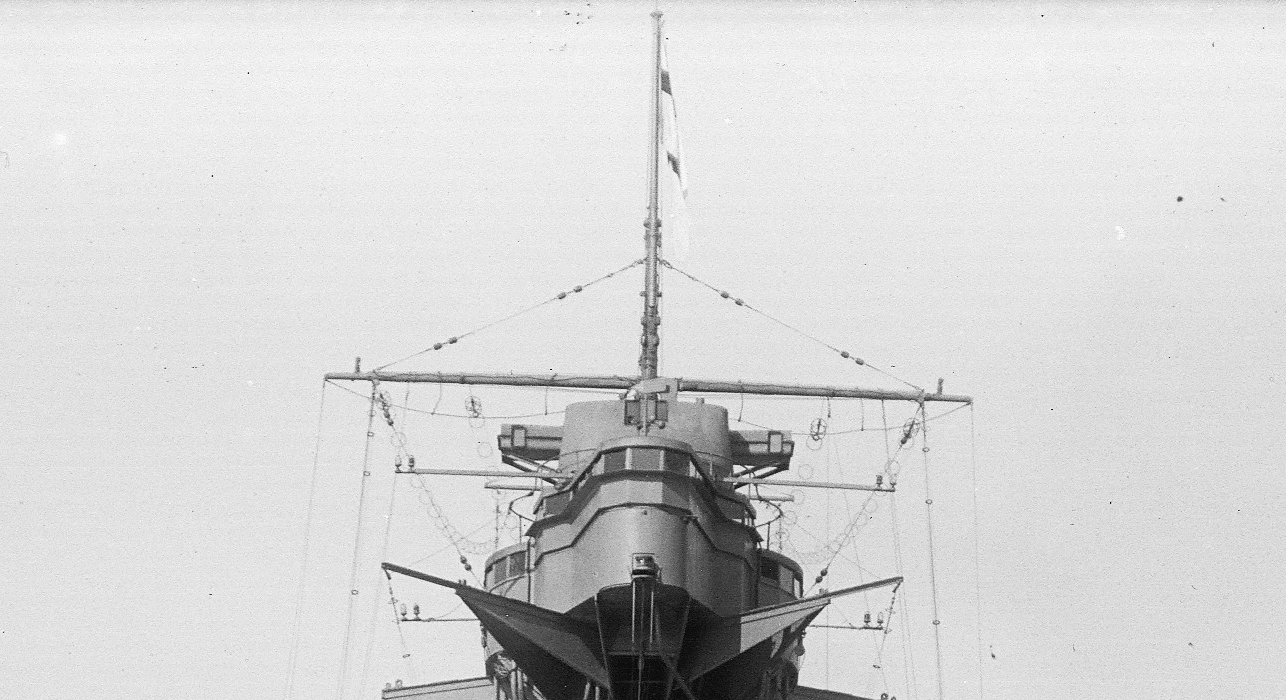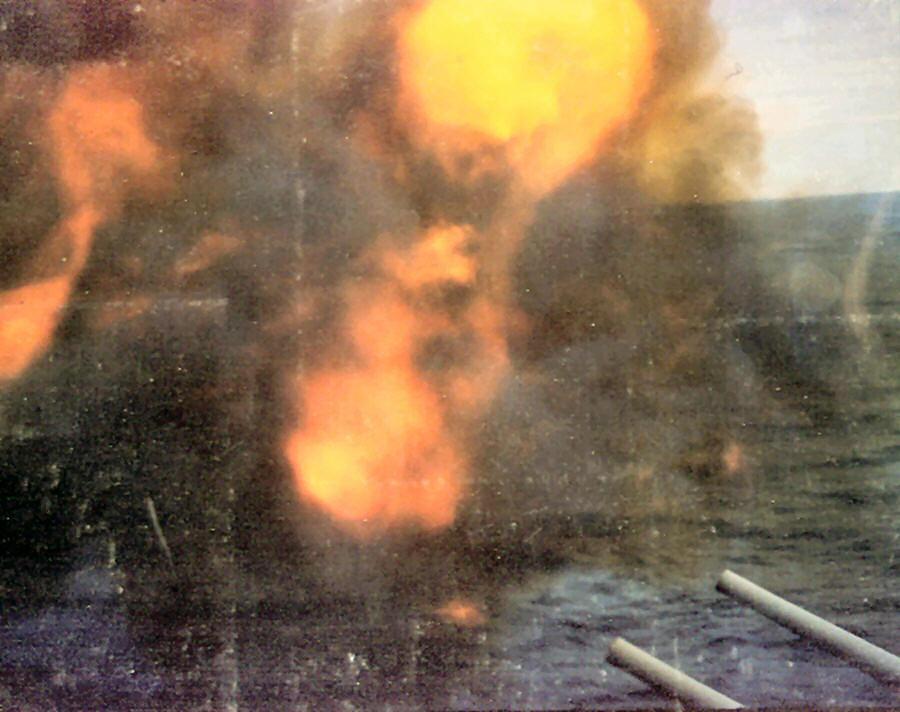In 1935, the Australis Navy started rebuilding the four Iron Duke Class battleships in their fleet. The rebuilding would leave the Australis Navy with four turrets of twin 13.5" guns. What to do with them. One thought was to build a new capital ship with eight guns. But the Australis Navy had just put three new King George V battleships with 8x15" into production and did not want to produce a lesser vessel, the main reason being the production of fourteen inch armour for those vessels would take all Australis had, no more could be produced for a fourth ship. The fifth unit of the Echidna class was just about complete and following that ship with two similar vessels armed with the 13.5" guns was the most probable outcome. The last type to be considered was the single turret monitor in the same layout/format as the Southern African Ostrich class.
In the end an updated and enlarged Echidna type was chosen. The new Cassowary Class would be almost 50% bigger, this size increase was made to increase the power plant, to provide space for their own spotting aircraft, and to enhance the size of the AA battery. The increase in power plant machinery increased the speed of the Cassowary to 26 knots compared to the 21 knots of the Echidna's. What the extra speed did was allow the two ships to move around with the battlefleet (Queen class and Iron Dukes). What came out was reminiscent of the Light Battlecruisers of 20 years before (Courageous Class).

Both ships were completed prior to the outbreak of war and were still finishing their trials and training. Having been completed in the last of peace the whole crew had been brought up to the peak of fitness, both ships were ready to go and do big things. Where to send them is my next problem. I have three Echidnas going to the Mediterranean to allow the Royal Navy monitors in the Med to be sent to home waters. The other two Echidnas are kept in home waters. I have one of the RN monitors going down the coast of South America and fighting two German cruisers. I could send the two Cassowaries after them, getting there two late to save Thunder but can pick up the survivors and transfer them to the Hospital ships that formed part of the forces retaking the Falklands. From assisting with the Falklands the ships can go north to the United Kingdom theater and go through Norway, then France, Dunkirk and then the neutralising of the French Fleet in Vichy North Africa. With the release of the German merchant raiders out onto the trade routes, these two ships, with their aircraft, were used to ride the trade routes searching for these vessels. Operating out of Perth and Durban and up to Trincomalee the huge area of the Indian Ocean was their hunting ground. As long as the sea was fair, the aircraft could be launched to extend the vision range of the ships. It was the aircraft from Koala that drew first blood. Sighting a merchantman that was not in an area it should be. Interrogation of the ship gave wrong answers and the Koala steamed for the spot the aircraft was circling and soon came up with the ship. The ship was claiming to be a Dutch merchantman, but that ship was supposed to be going up the coast of Africa to Aden. All of the Koalas guns were loaded and pointing the right way. All of a sudden the ship lurched to one side and a puff of debris from an explosion puffed out from the side of the ship. The ship was scuttling itself. The Koala put on some speed and closed with the ship. It was actually the Dutch ship that had been caught and captured by the raider Aries, which was using it as a stores ship. The ship also had prisoners aboard and these and the prize crew were jumping into the ships boats which had been launched. The ships boats were picked up by the Koala, and the captors became the captured, and the Dutch crew were free again. Both lots were dropped off at Durban.
Having confirmed that a raider was loose in the Indian Ocean, hunting parties were put together to hunt the Aries down. From Southern Africa, the Lesotho (CVE) and Wildebeest (TS) were the killer group, while several escorts were used as beaters to force the Aries down to the guns. The two brand new Southern African Sirius class cruisers were sent out on their own along the trade routes, while the convoy escorts had to be strengthened. Australis had the two Echidna class ships and the CVL Carpentaria operating out of Darwin with the two Kimberley class battlecruisers to close the Northern routes out of the Indian Ocean. The Van Diemen and two of the Dukes are sent from Melbourne across to Perth and are there to close the southern exits from the Indian Ocean around the bottom of Australia. A lot of firepower to chase down one raider. But one raider can cause a lot of damage to unarmed merchantmen while it is at large. In actual fact there were two raiders in the Indian Ocean at that time, the Aries and the Krokodial. The distress signal from the captured Dutch ship alerted them both that the Allies now knew for sure a raider was at large in the Indian Ocean. The Krokodial was in the Northern part of the Indian Ocean trying to interdict the trade routes from Singapore to India / Ceylon / Aden. It sank two ships quickly and decided to change area by going through the Malacca Strait past Singapore and into the South China Sea. In the Malacca Strait was the Thylacine, the Krokodial could not pass the interrogation test and dropped its disguise and opened fire at maximum range of its old 5.9" guns. The end was very swift, three hits from the Thylacines 12" guns virtually blew the Krokodial apart. Part of its plan had been to drop half of its mines armament in and around Singapore to create havoc in that area. The mines now provided the catalyst for the Krokodial's demise. One 12" shell into the mine deck and the ship almost vapourised. Only six survivors could be found. One down.

The Cassowary and Koala had defined patrol lines on the most important routes, Perth to Durban, and Perth to Aden. HMAS Brabant was at Diego Garcia acting as mothership to a squadron of old Supermarine Stranraer flying boats which were providing a sterling service of keeping an eye on the area around Diego Garcia. The Aries drew a circle around Diego Garcia at the range of the flying boats and had to treat it as a no go zone. Aries Kapitan would have liked to get close to Diego Garcia and shell the flying boat installation, but had no knowledge of the defences, better to leave it alone. What the flying boats did was to squeeze the Aries into areas where it would be easier to spot. And so it proved. The Cassowary launched its aircraft at dawn with orders to fly a triangle search pattern to the north of the ship, out toward Diego Garcia. Thirty minutes later the aircraft radios that it has a merchant ship in sight that it is not answering signals. The aircraft gave its position and the Cassowary headed for the spot. Further communication with the aircraft ensued and finally replies from the merchantmen started to come in. A last message was cut short with a startled voice saying "What's an Arado doing out here". Silence ensued after that but the Cassowary was close to the last position of the ship given by its aircraft and full speed was ordered, the Aries would not escape. Just minutes later an aircraft was spotted, but it was not their aircraft, and seeing the Cassowary turned and headed back the way it had come from. The Cassowary was pounding along in the same direction at 25 knots. A radar contact was made at 35,000 yards while visibility was at 26-28,000 yards. The chase was on. The ship ahead was going as fast as it could at 19 knots, and it had been advised by its aircraft that a Capital Ship with big guns was chasing. If the Aries could keep the Cassowary at bay long enough for night to fall, it might yet escape. With a six knot closing speed the Cassowary came into sight and then range of the Aries in ninety minutes. Three hours of daylight left the Aries goose was well and truly cooked. The Aries Kapitan then did something that would be hailed and bring praise to his name, the prisoners from the captured and sunk ships onboard Aries, were put into two of the Aries lifeboats, the Aries slowed drastically for a minute while the boats were launched and then went to full speed again. Whether Aries was hoping the Cassowary would stop and collect the crew from the boats, the Cassowary's Captain decided the people aboard the boats would be safer aboard the boats than aboard a ship going into battle. They could be picked up later. At 22,000 yards the Cassowary opened fire, the 13.5" shells being under radar controlled director firing were fairly accurate. But with only two gun salvoes from the forward guns the chances of hits were not very high. The Aries started to zig-zag to put off the Cassowaries gunners but all that did was to bring the Cassowary closer, faster. At 18,000 yards (and still outside the range of the old 5.9" aboard the Aries) the Cassowary turned to allow the aft turret to bear on the Aries. Having four gun salvoes paid off almost immediately with a hit being scored on the Aries. The Cassowary was firing high explosive, contact, shells and the hit blasted the side out of the ship and the Aries slowed dramatically as the engine room is sprayed with splinters that cut lines and damage the engines themselves. Just two more hits and the Aries is a wreck, dead in the water and down by the head. The German sailors lower the remaining lifeboats and start throwing liferafts over the side. A puff of smoke and the Aries starts to settle faster, the Aries has fired scuttling charges. The Cassowary sends its powered lifeboats to help pick up survivors. The Cassowary itself would not approach the Aries till it had sunk, just in case some ardent Nazi had stayed aboard to launch torpedoes. Collecting the prisoners, then the Allied survivors the Cassowary went to Perth to be hailed and feted for its victory. Two down.

Foretop of Cassowary as completed in December 1938.
The array of power had achieved its aim, both enemy raiders being caught and sunk in a reasonable amount of time. The extra defences required had to be pulled from other places and opened those areas to attack from different directions. The removal of four escorts from the Simonstown to Sierra Leone route allowed a submarine to attack a lesser protected convoy and sink three ships. That event may have happened anyway but having less escorts made sure it could happen. By the end of July 1940 all of the German raiders, both merchant and warship, had been accounted for. Extra forces covering the exits into the Atlantic would stop any further large warship excursions but the odd merchant raider would sneak through. The focus for the Australis forces during the next eighteen months would be the Mediterranean Theater. The Cassowary and Koala would be in their element doing what they were built to do, support the Army with shore bombardment.
Koala is withdrawn from the Mediterranean in 1943, and sent to provide fire support for Australis and American troops retaking the Japanese held Pacific Islands. October 1944 and the Koala is with the fire support group when the Japanese Fleet appears at the mouth of Leyte Gulf. Koala heads off after the American Destroyers firing at the biggest target it can see, the mighty Yamato. The Japanese seeing large shell splashes arriving from Koalas 13.5" guns, target poor Koala, and after several 16" and 18" hits is a wreck, both turrets have been dismounted, gaping holes have appeared in the hull, and fires are sweeping the decks from stem to stern. Twenty minutes later the Koala sinks from the stern taking a large percentage of its crew with it. The only satisfaction the survivors of HMAS Koala can take away is the knowledge that the four hits they scored on the Yamato probably helped make up the Japanese Admirals mind to retreat.
